Port of Rotterdam and Port of Melbourne: Challenges and Solutions
VerifiedAdded on 2023/06/11
|15
|3466
|329
AI Summary
This article discusses the challenges faced by Port of Rotterdam and Port of Melbourne in transportation and freight logistics. It covers the background of seaports, the nature of cargo ports, and the challenges faced by both ports, including CO2 emissions, governance policies, rail and road inefficiencies, and spacing issues. The article also provides a comparison of the challenges faced by both ports and offers recommendations for solutions.
Contribute Materials
Your contribution can guide someone’s learning journey. Share your
documents today.
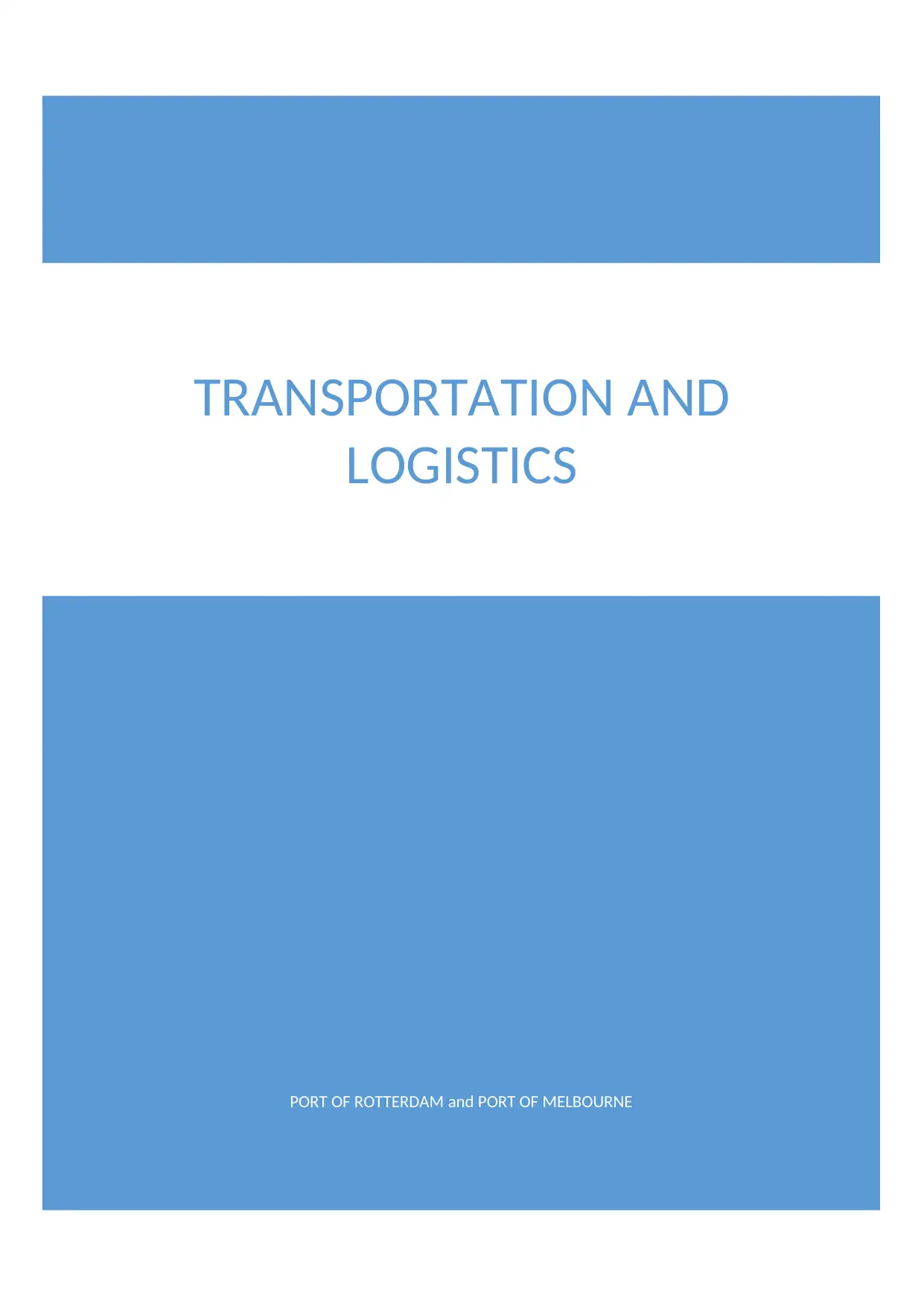
PORT OF ROTTERDAM and PORT OF MELBOURNE
TRANSPORTATION AND
LOGISTICS
TRANSPORTATION AND
LOGISTICS
Secure Best Marks with AI Grader
Need help grading? Try our AI Grader for instant feedback on your assignments.

Transportation and freight logistics: 1
Executive summary
A port is a commercial place, which enables the trade between different countries. A port
provides commercial which comprises ships, large vessels, cargo, and passengers. The
classification of ports is as per their nature of how they operate such as- seaport, cargo port,
inland port, and fishing port. Port of Rotterdam and port of Melbourne are the types of cargo
ports. These ports carry maximum cargo among all the ports. However, there are many
challenges faced by both individually. The problem of co2 emission and governance policies
hinders the ports to develop their operations. Whereas, Melbourne problem relates to rail,
road and the inefficient freight transport operations. The Solution to challenges is to control
the use of fossil fuels, which will reduce the emission of co2. The major challenge, which
both the port faces, is the problem of space. The infrastructure and nearby space is to be
increased so that, they can expand their operations.
Executive summary
A port is a commercial place, which enables the trade between different countries. A port
provides commercial which comprises ships, large vessels, cargo, and passengers. The
classification of ports is as per their nature of how they operate such as- seaport, cargo port,
inland port, and fishing port. Port of Rotterdam and port of Melbourne are the types of cargo
ports. These ports carry maximum cargo among all the ports. However, there are many
challenges faced by both individually. The problem of co2 emission and governance policies
hinders the ports to develop their operations. Whereas, Melbourne problem relates to rail,
road and the inefficient freight transport operations. The Solution to challenges is to control
the use of fossil fuels, which will reduce the emission of co2. The major challenge, which
both the port faces, is the problem of space. The infrastructure and nearby space is to be
increased so that, they can expand their operations.
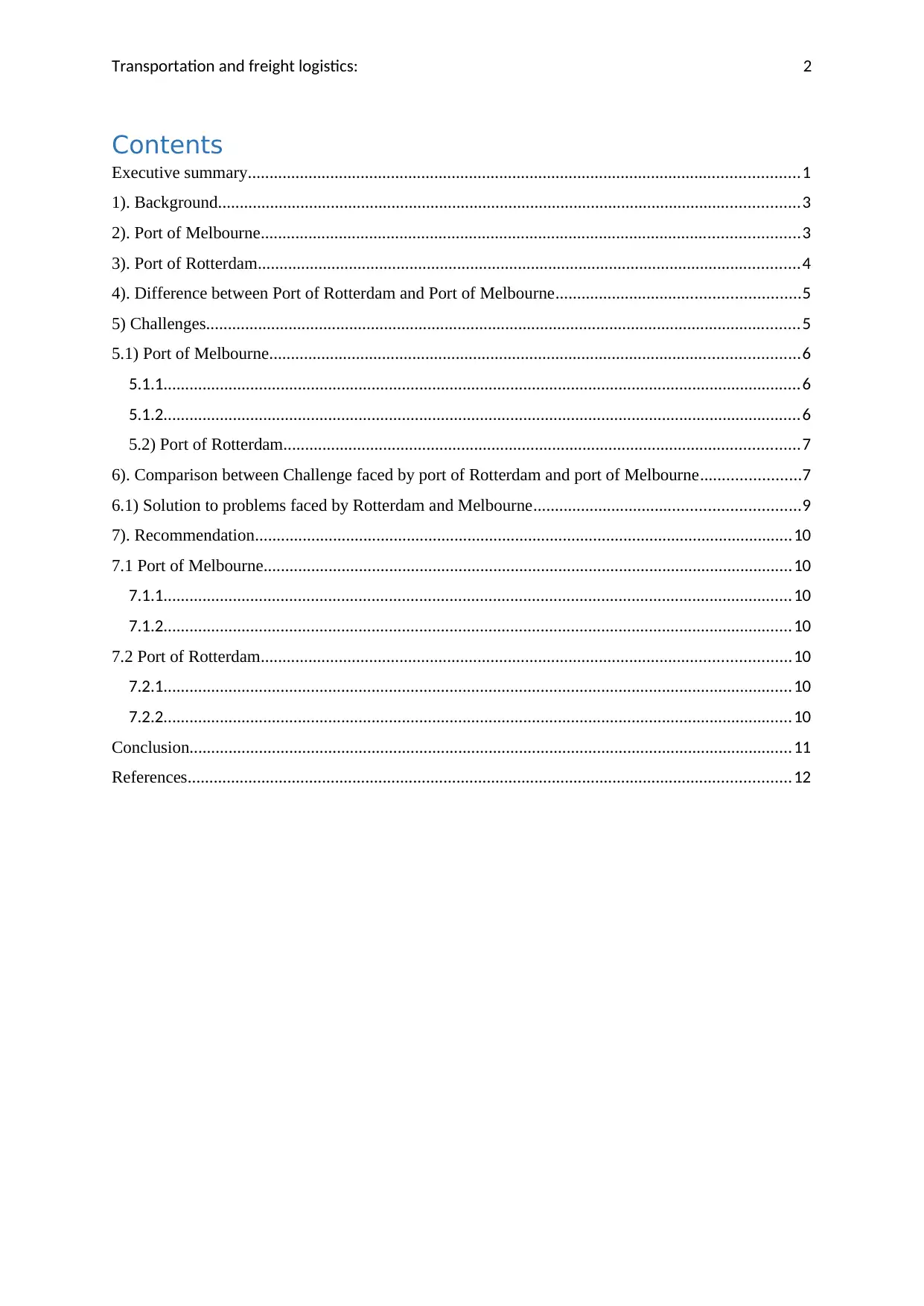
Transportation and freight logistics: 2
Contents
Executive summary...............................................................................................................................1
1). Background......................................................................................................................................3
2). Port of Melbourne............................................................................................................................3
3). Port of Rotterdam.............................................................................................................................4
4). Difference between Port of Rotterdam and Port of Melbourne........................................................5
5) Challenges.........................................................................................................................................5
5.1) Port of Melbourne..........................................................................................................................6
5.1.1...................................................................................................................................................6
5.1.2...................................................................................................................................................6
5.2) Port of Rotterdam.......................................................................................................................7
6). Comparison between Challenge faced by port of Rotterdam and port of Melbourne.......................7
6.1) Solution to problems faced by Rotterdam and Melbourne.............................................................9
7). Recommendation............................................................................................................................10
7.1 Port of Melbourne..........................................................................................................................10
7.1.1.................................................................................................................................................10
7.1.2.................................................................................................................................................10
7.2 Port of Rotterdam..........................................................................................................................10
7.2.1.................................................................................................................................................10
7.2.2.................................................................................................................................................10
Conclusion...........................................................................................................................................11
References...........................................................................................................................................12
Contents
Executive summary...............................................................................................................................1
1). Background......................................................................................................................................3
2). Port of Melbourne............................................................................................................................3
3). Port of Rotterdam.............................................................................................................................4
4). Difference between Port of Rotterdam and Port of Melbourne........................................................5
5) Challenges.........................................................................................................................................5
5.1) Port of Melbourne..........................................................................................................................6
5.1.1...................................................................................................................................................6
5.1.2...................................................................................................................................................6
5.2) Port of Rotterdam.......................................................................................................................7
6). Comparison between Challenge faced by port of Rotterdam and port of Melbourne.......................7
6.1) Solution to problems faced by Rotterdam and Melbourne.............................................................9
7). Recommendation............................................................................................................................10
7.1 Port of Melbourne..........................................................................................................................10
7.1.1.................................................................................................................................................10
7.1.2.................................................................................................................................................10
7.2 Port of Rotterdam..........................................................................................................................10
7.2.1.................................................................................................................................................10
7.2.2.................................................................................................................................................10
Conclusion...........................................................................................................................................11
References...........................................................................................................................................12

Transportation and freight logistics: 3
1). Background
The role of seaports cannot be undermined in the efficient working of the world
economy. Most countries that are engaged in international trade needs water transport. The
port of Rotterdam is famous as distribution hub in Europe and the port of Melbourne in
Victoria, Australia is famous for maximum cargo capacity. Every port has its own authority
that maintains the efficiency and manages the berths, cranes, roads, and storage facilities.
Both the ports have high traffic in the whole year. Apart from economic benefit, Port of
Melbourne also provides education to children and students, so increasing the employment
opportunity for the people surrounding the port. Managing the port area, berth, docks, and
storage yards is complex. There are various challenges faced by the port due to high traffic.
The most related challenge is spacing. The Port of Rotterdam is most efficient in
warehousing and distributing the consumer goods- dry products, vegetable products.
Rotterdam tries to control CO2 emission and engage wind turbines to protect the environment
near the port. The port group says that if they do not take any step, there is a possibility of
only CO2 surrounding the whole port. The major challenges faced by both the ports are
spacing and the ways to resolve those problems.
2). Port of Melbourne
The port of Melbourne is situated in Melbourne, Victoria. The port of Melbourne is
one of the largest container ports in Australia. More than 3000 ships visits this port every
year. After discovering gold in 1850s, the trade has grown more. The port formed the
Melbourne harbor trust was formed in 1877 to delegate the authority to develop and manage
the port and speeding the international trade links. The port of Melbourne group manages the
commercial operation held by Victoria government on September, 2016. Port of Melbourne is
the largest general cargo port in Australia (portofmelbourne, 2018). The main service
1). Background
The role of seaports cannot be undermined in the efficient working of the world
economy. Most countries that are engaged in international trade needs water transport. The
port of Rotterdam is famous as distribution hub in Europe and the port of Melbourne in
Victoria, Australia is famous for maximum cargo capacity. Every port has its own authority
that maintains the efficiency and manages the berths, cranes, roads, and storage facilities.
Both the ports have high traffic in the whole year. Apart from economic benefit, Port of
Melbourne also provides education to children and students, so increasing the employment
opportunity for the people surrounding the port. Managing the port area, berth, docks, and
storage yards is complex. There are various challenges faced by the port due to high traffic.
The most related challenge is spacing. The Port of Rotterdam is most efficient in
warehousing and distributing the consumer goods- dry products, vegetable products.
Rotterdam tries to control CO2 emission and engage wind turbines to protect the environment
near the port. The port group says that if they do not take any step, there is a possibility of
only CO2 surrounding the whole port. The major challenges faced by both the ports are
spacing and the ways to resolve those problems.
2). Port of Melbourne
The port of Melbourne is situated in Melbourne, Victoria. The port of Melbourne is
one of the largest container ports in Australia. More than 3000 ships visits this port every
year. After discovering gold in 1850s, the trade has grown more. The port formed the
Melbourne harbor trust was formed in 1877 to delegate the authority to develop and manage
the port and speeding the international trade links. The port of Melbourne group manages the
commercial operation held by Victoria government on September, 2016. Port of Melbourne is
the largest general cargo port in Australia (portofmelbourne, 2018). The main service
Secure Best Marks with AI Grader
Need help grading? Try our AI Grader for instant feedback on your assignments.
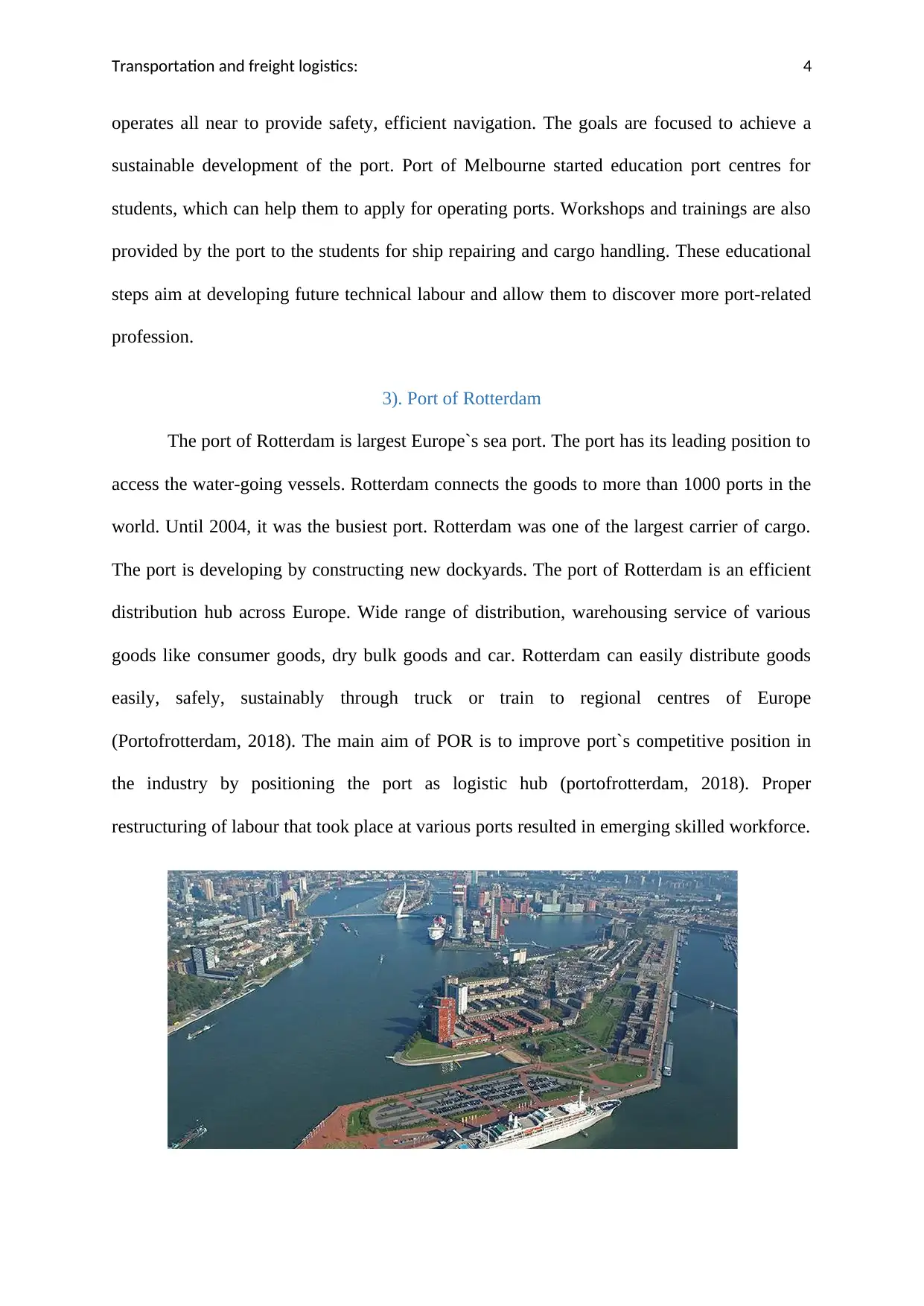
Transportation and freight logistics: 4
operates all near to provide safety, efficient navigation. The goals are focused to achieve a
sustainable development of the port. Port of Melbourne started education port centres for
students, which can help them to apply for operating ports. Workshops and trainings are also
provided by the port to the students for ship repairing and cargo handling. These educational
steps aim at developing future technical labour and allow them to discover more port-related
profession.
3). Port of Rotterdam
The port of Rotterdam is largest Europe`s sea port. The port has its leading position to
access the water-going vessels. Rotterdam connects the goods to more than 1000 ports in the
world. Until 2004, it was the busiest port. Rotterdam was one of the largest carrier of cargo.
The port is developing by constructing new dockyards. The port of Rotterdam is an efficient
distribution hub across Europe. Wide range of distribution, warehousing service of various
goods like consumer goods, dry bulk goods and car. Rotterdam can easily distribute goods
easily, safely, sustainably through truck or train to regional centres of Europe
(Portofrotterdam, 2018). The main aim of POR is to improve port`s competitive position in
the industry by positioning the port as logistic hub (portofrotterdam, 2018). Proper
restructuring of labour that took place at various ports resulted in emerging skilled workforce.
operates all near to provide safety, efficient navigation. The goals are focused to achieve a
sustainable development of the port. Port of Melbourne started education port centres for
students, which can help them to apply for operating ports. Workshops and trainings are also
provided by the port to the students for ship repairing and cargo handling. These educational
steps aim at developing future technical labour and allow them to discover more port-related
profession.
3). Port of Rotterdam
The port of Rotterdam is largest Europe`s sea port. The port has its leading position to
access the water-going vessels. Rotterdam connects the goods to more than 1000 ports in the
world. Until 2004, it was the busiest port. Rotterdam was one of the largest carrier of cargo.
The port is developing by constructing new dockyards. The port of Rotterdam is an efficient
distribution hub across Europe. Wide range of distribution, warehousing service of various
goods like consumer goods, dry bulk goods and car. Rotterdam can easily distribute goods
easily, safely, sustainably through truck or train to regional centres of Europe
(Portofrotterdam, 2018). The main aim of POR is to improve port`s competitive position in
the industry by positioning the port as logistic hub (portofrotterdam, 2018). Proper
restructuring of labour that took place at various ports resulted in emerging skilled workforce.
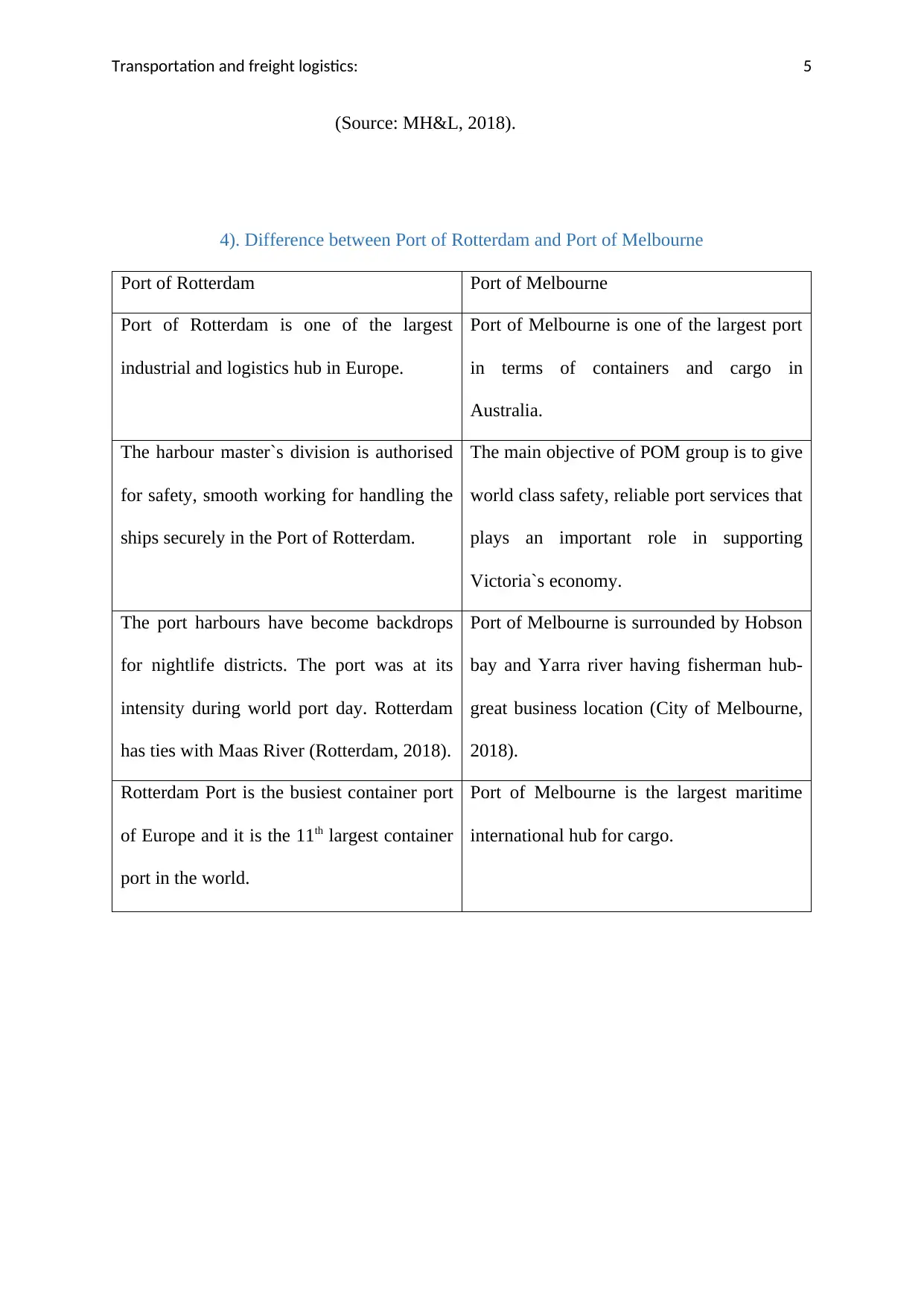
Transportation and freight logistics: 5
(Source: MH&L, 2018).
4). Difference between Port of Rotterdam and Port of Melbourne
Port of Rotterdam Port of Melbourne
Port of Rotterdam is one of the largest
industrial and logistics hub in Europe.
Port of Melbourne is one of the largest port
in terms of containers and cargo in
Australia.
The harbour master`s division is authorised
for safety, smooth working for handling the
ships securely in the Port of Rotterdam.
The main objective of POM group is to give
world class safety, reliable port services that
plays an important role in supporting
Victoria`s economy.
The port harbours have become backdrops
for nightlife districts. The port was at its
intensity during world port day. Rotterdam
has ties with Maas River (Rotterdam, 2018).
Port of Melbourne is surrounded by Hobson
bay and Yarra river having fisherman hub-
great business location (City of Melbourne,
2018).
Rotterdam Port is the busiest container port
of Europe and it is the 11th largest container
port in the world.
Port of Melbourne is the largest maritime
international hub for cargo.
(Source: MH&L, 2018).
4). Difference between Port of Rotterdam and Port of Melbourne
Port of Rotterdam Port of Melbourne
Port of Rotterdam is one of the largest
industrial and logistics hub in Europe.
Port of Melbourne is one of the largest port
in terms of containers and cargo in
Australia.
The harbour master`s division is authorised
for safety, smooth working for handling the
ships securely in the Port of Rotterdam.
The main objective of POM group is to give
world class safety, reliable port services that
plays an important role in supporting
Victoria`s economy.
The port harbours have become backdrops
for nightlife districts. The port was at its
intensity during world port day. Rotterdam
has ties with Maas River (Rotterdam, 2018).
Port of Melbourne is surrounded by Hobson
bay and Yarra river having fisherman hub-
great business location (City of Melbourne,
2018).
Rotterdam Port is the busiest container port
of Europe and it is the 11th largest container
port in the world.
Port of Melbourne is the largest maritime
international hub for cargo.
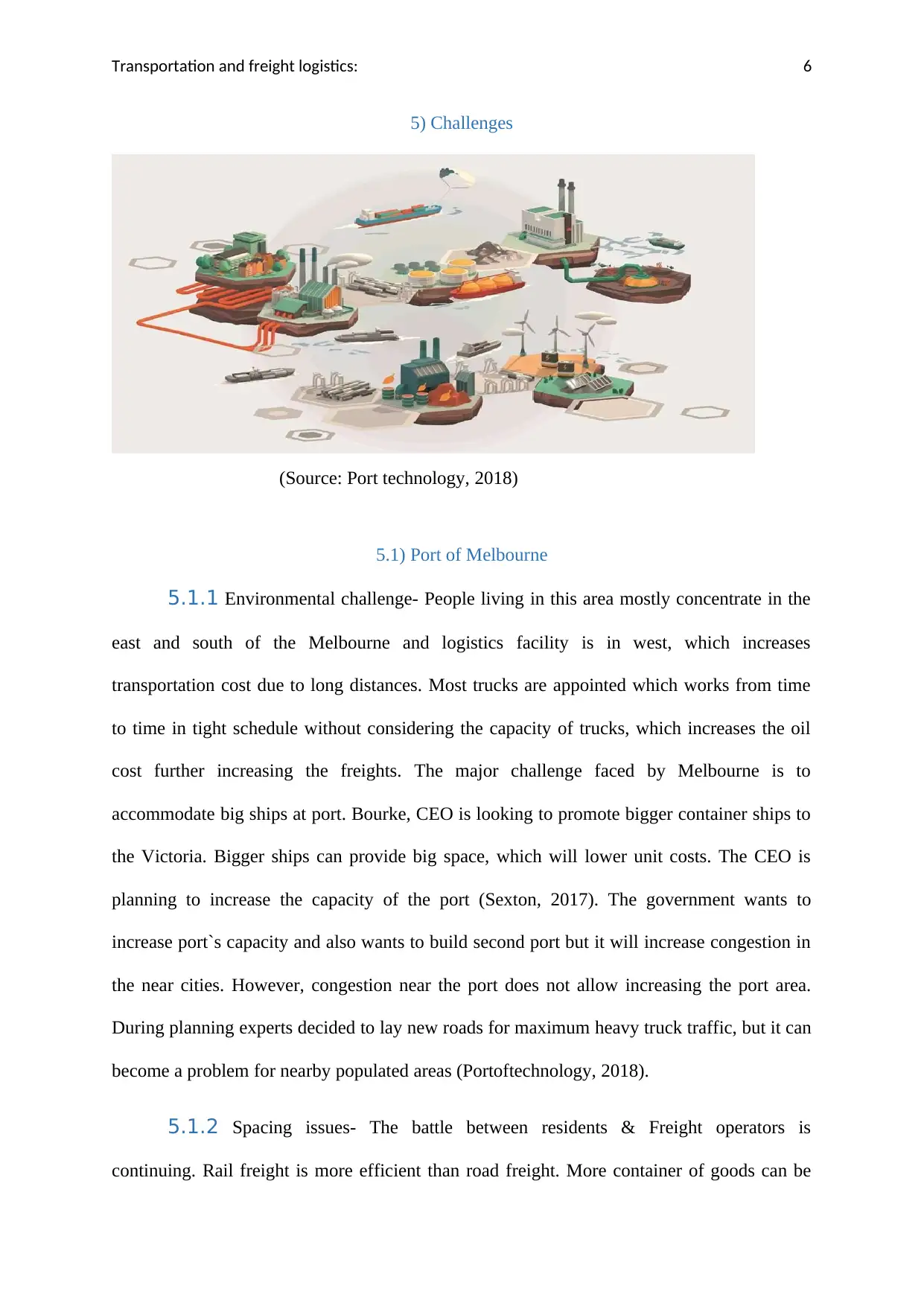
Transportation and freight logistics: 6
5) Challenges
(Source: Port technology, 2018)
5.1) Port of Melbourne
5.1.1 Environmental challenge- People living in this area mostly concentrate in the
east and south of the Melbourne and logistics facility is in west, which increases
transportation cost due to long distances. Most trucks are appointed which works from time
to time in tight schedule without considering the capacity of trucks, which increases the oil
cost further increasing the freights. The major challenge faced by Melbourne is to
accommodate big ships at port. Bourke, CEO is looking to promote bigger container ships to
the Victoria. Bigger ships can provide big space, which will lower unit costs. The CEO is
planning to increase the capacity of the port (Sexton, 2017). The government wants to
increase port`s capacity and also wants to build second port but it will increase congestion in
the near cities. However, congestion near the port does not allow increasing the port area.
During planning experts decided to lay new roads for maximum heavy truck traffic, but it can
become a problem for nearby populated areas (Portoftechnology, 2018).
5.1.2 Spacing issues- The battle between residents & Freight operators is
continuing. Rail freight is more efficient than road freight. More container of goods can be
5) Challenges
(Source: Port technology, 2018)
5.1) Port of Melbourne
5.1.1 Environmental challenge- People living in this area mostly concentrate in the
east and south of the Melbourne and logistics facility is in west, which increases
transportation cost due to long distances. Most trucks are appointed which works from time
to time in tight schedule without considering the capacity of trucks, which increases the oil
cost further increasing the freights. The major challenge faced by Melbourne is to
accommodate big ships at port. Bourke, CEO is looking to promote bigger container ships to
the Victoria. Bigger ships can provide big space, which will lower unit costs. The CEO is
planning to increase the capacity of the port (Sexton, 2017). The government wants to
increase port`s capacity and also wants to build second port but it will increase congestion in
the near cities. However, congestion near the port does not allow increasing the port area.
During planning experts decided to lay new roads for maximum heavy truck traffic, but it can
become a problem for nearby populated areas (Portoftechnology, 2018).
5.1.2 Spacing issues- The battle between residents & Freight operators is
continuing. Rail freight is more efficient than road freight. More container of goods can be
Paraphrase This Document
Need a fresh take? Get an instant paraphrase of this document with our AI Paraphraser
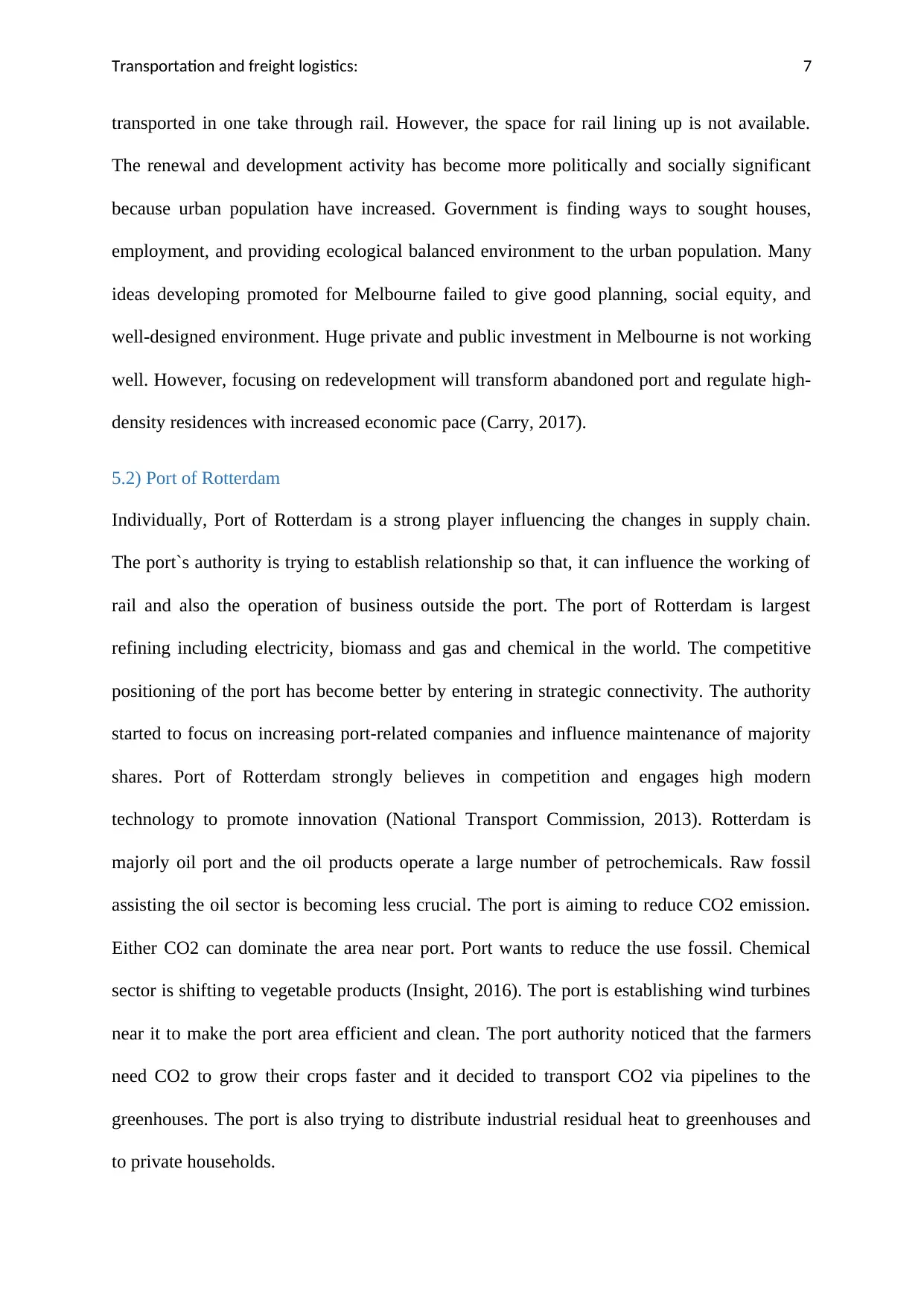
Transportation and freight logistics: 7
transported in one take through rail. However, the space for rail lining up is not available.
The renewal and development activity has become more politically and socially significant
because urban population have increased. Government is finding ways to sought houses,
employment, and providing ecological balanced environment to the urban population. Many
ideas developing promoted for Melbourne failed to give good planning, social equity, and
well-designed environment. Huge private and public investment in Melbourne is not working
well. However, focusing on redevelopment will transform abandoned port and regulate high-
density residences with increased economic pace (Carry, 2017).
5.2) Port of Rotterdam
Individually, Port of Rotterdam is a strong player influencing the changes in supply chain.
The port`s authority is trying to establish relationship so that, it can influence the working of
rail and also the operation of business outside the port. The port of Rotterdam is largest
refining including electricity, biomass and gas and chemical in the world. The competitive
positioning of the port has become better by entering in strategic connectivity. The authority
started to focus on increasing port-related companies and influence maintenance of majority
shares. Port of Rotterdam strongly believes in competition and engages high modern
technology to promote innovation (National Transport Commission, 2013). Rotterdam is
majorly oil port and the oil products operate a large number of petrochemicals. Raw fossil
assisting the oil sector is becoming less crucial. The port is aiming to reduce CO2 emission.
Either CO2 can dominate the area near port. Port wants to reduce the use fossil. Chemical
sector is shifting to vegetable products (Insight, 2016). The port is establishing wind turbines
near it to make the port area efficient and clean. The port authority noticed that the farmers
need CO2 to grow their crops faster and it decided to transport CO2 via pipelines to the
greenhouses. The port is also trying to distribute industrial residual heat to greenhouses and
to private households.
transported in one take through rail. However, the space for rail lining up is not available.
The renewal and development activity has become more politically and socially significant
because urban population have increased. Government is finding ways to sought houses,
employment, and providing ecological balanced environment to the urban population. Many
ideas developing promoted for Melbourne failed to give good planning, social equity, and
well-designed environment. Huge private and public investment in Melbourne is not working
well. However, focusing on redevelopment will transform abandoned port and regulate high-
density residences with increased economic pace (Carry, 2017).
5.2) Port of Rotterdam
Individually, Port of Rotterdam is a strong player influencing the changes in supply chain.
The port`s authority is trying to establish relationship so that, it can influence the working of
rail and also the operation of business outside the port. The port of Rotterdam is largest
refining including electricity, biomass and gas and chemical in the world. The competitive
positioning of the port has become better by entering in strategic connectivity. The authority
started to focus on increasing port-related companies and influence maintenance of majority
shares. Port of Rotterdam strongly believes in competition and engages high modern
technology to promote innovation (National Transport Commission, 2013). Rotterdam is
majorly oil port and the oil products operate a large number of petrochemicals. Raw fossil
assisting the oil sector is becoming less crucial. The port is aiming to reduce CO2 emission.
Either CO2 can dominate the area near port. Port wants to reduce the use fossil. Chemical
sector is shifting to vegetable products (Insight, 2016). The port is establishing wind turbines
near it to make the port area efficient and clean. The port authority noticed that the farmers
need CO2 to grow their crops faster and it decided to transport CO2 via pipelines to the
greenhouses. The port is also trying to distribute industrial residual heat to greenhouses and
to private households.
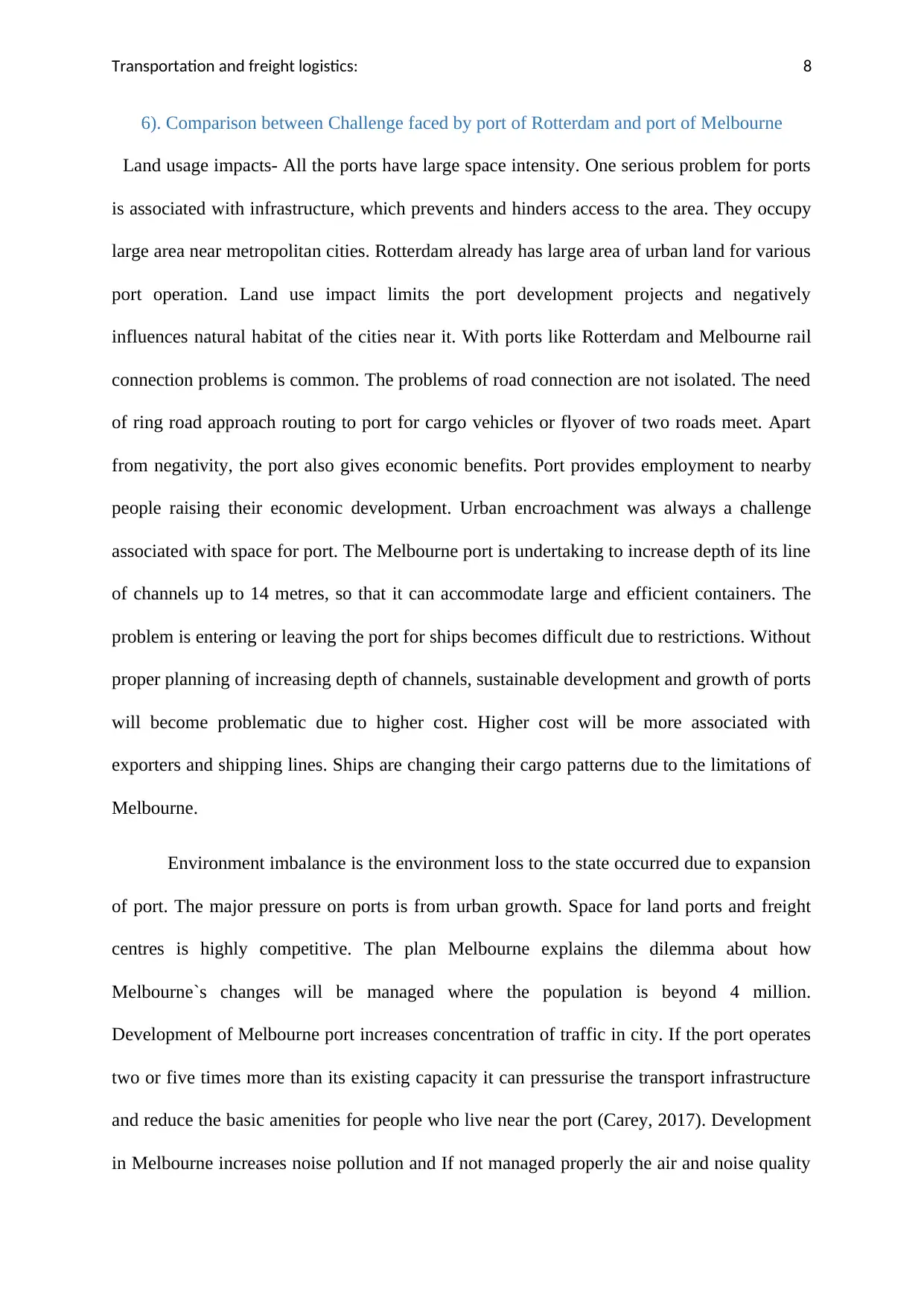
Transportation and freight logistics: 8
6). Comparison between Challenge faced by port of Rotterdam and port of Melbourne
Land usage impacts- All the ports have large space intensity. One serious problem for ports
is associated with infrastructure, which prevents and hinders access to the area. They occupy
large area near metropolitan cities. Rotterdam already has large area of urban land for various
port operation. Land use impact limits the port development projects and negatively
influences natural habitat of the cities near it. With ports like Rotterdam and Melbourne rail
connection problems is common. The problems of road connection are not isolated. The need
of ring road approach routing to port for cargo vehicles or flyover of two roads meet. Apart
from negativity, the port also gives economic benefits. Port provides employment to nearby
people raising their economic development. Urban encroachment was always a challenge
associated with space for port. The Melbourne port is undertaking to increase depth of its line
of channels up to 14 metres, so that it can accommodate large and efficient containers. The
problem is entering or leaving the port for ships becomes difficult due to restrictions. Without
proper planning of increasing depth of channels, sustainable development and growth of ports
will become problematic due to higher cost. Higher cost will be more associated with
exporters and shipping lines. Ships are changing their cargo patterns due to the limitations of
Melbourne.
Environment imbalance is the environment loss to the state occurred due to expansion
of port. The major pressure on ports is from urban growth. Space for land ports and freight
centres is highly competitive. The plan Melbourne explains the dilemma about how
Melbourne`s changes will be managed where the population is beyond 4 million.
Development of Melbourne port increases concentration of traffic in city. If the port operates
two or five times more than its existing capacity it can pressurise the transport infrastructure
and reduce the basic amenities for people who live near the port (Carey, 2017). Development
in Melbourne increases noise pollution and If not managed properly the air and noise quality
6). Comparison between Challenge faced by port of Rotterdam and port of Melbourne
Land usage impacts- All the ports have large space intensity. One serious problem for ports
is associated with infrastructure, which prevents and hinders access to the area. They occupy
large area near metropolitan cities. Rotterdam already has large area of urban land for various
port operation. Land use impact limits the port development projects and negatively
influences natural habitat of the cities near it. With ports like Rotterdam and Melbourne rail
connection problems is common. The problems of road connection are not isolated. The need
of ring road approach routing to port for cargo vehicles or flyover of two roads meet. Apart
from negativity, the port also gives economic benefits. Port provides employment to nearby
people raising their economic development. Urban encroachment was always a challenge
associated with space for port. The Melbourne port is undertaking to increase depth of its line
of channels up to 14 metres, so that it can accommodate large and efficient containers. The
problem is entering or leaving the port for ships becomes difficult due to restrictions. Without
proper planning of increasing depth of channels, sustainable development and growth of ports
will become problematic due to higher cost. Higher cost will be more associated with
exporters and shipping lines. Ships are changing their cargo patterns due to the limitations of
Melbourne.
Environment imbalance is the environment loss to the state occurred due to expansion
of port. The major pressure on ports is from urban growth. Space for land ports and freight
centres is highly competitive. The plan Melbourne explains the dilemma about how
Melbourne`s changes will be managed where the population is beyond 4 million.
Development of Melbourne port increases concentration of traffic in city. If the port operates
two or five times more than its existing capacity it can pressurise the transport infrastructure
and reduce the basic amenities for people who live near the port (Carey, 2017). Development
in Melbourne increases noise pollution and If not managed properly the air and noise quality

Transportation and freight logistics: 9
issues of truck traffic near port is increased. Government plans to provide houses to people on
the port`s doorstep (Wilmsmeier and Zarzoso, 2010). Problems of parking increase the
number of ships at the port as well as risking their safety. The rising cost of fuel pulls
shipping companies to reduce their operational costs. By entering into the international
market and promoting open economy. The heavy number of ships due to china`s growing
demand leads to shortage of vessels.
(Source: Rodrigue, & Notteboom, 2018)
6.1) Solution to problems faced by Rotterdam and Melbourne
The solution to larger vessels of cargo can be solved by allowing the ships to stay in
deep water. Ports responded to the unsatisfied growing through investing in dredging
equipment and cranes to adjust big vessels. Ports tried to do major investment on replacing
their older assets and buying the vessels which has lager capacity to accommodate goods.
The purpose of identifying the space related problems were to introduce innovative
containers because of lack of container space area. Establish the residential areas much far
from the seas and oceans where ports can be build, then the problem of expanding the new or
existing ports can be solved easily. The ports can also use off-dock sites by assembling the
containers at a point before moving them to a destination. It will help to store empty
containers.
issues of truck traffic near port is increased. Government plans to provide houses to people on
the port`s doorstep (Wilmsmeier and Zarzoso, 2010). Problems of parking increase the
number of ships at the port as well as risking their safety. The rising cost of fuel pulls
shipping companies to reduce their operational costs. By entering into the international
market and promoting open economy. The heavy number of ships due to china`s growing
demand leads to shortage of vessels.
(Source: Rodrigue, & Notteboom, 2018)
6.1) Solution to problems faced by Rotterdam and Melbourne
The solution to larger vessels of cargo can be solved by allowing the ships to stay in
deep water. Ports responded to the unsatisfied growing through investing in dredging
equipment and cranes to adjust big vessels. Ports tried to do major investment on replacing
their older assets and buying the vessels which has lager capacity to accommodate goods.
The purpose of identifying the space related problems were to introduce innovative
containers because of lack of container space area. Establish the residential areas much far
from the seas and oceans where ports can be build, then the problem of expanding the new or
existing ports can be solved easily. The ports can also use off-dock sites by assembling the
containers at a point before moving them to a destination. It will help to store empty
containers.
Secure Best Marks with AI Grader
Need help grading? Try our AI Grader for instant feedback on your assignments.

Transportation and freight logistics: 10
By continuously using these off-dock sites, they become the extension part of
platform to handle extra volume. Bigger ships having high capacity are preferred more and
even the shipping industry started making more huge ships to avoid the double use of fuel.
The way containers are filled and loaded at the origin may create challenges related to
operation when it arrives at berth. The vessels filled with such a huge capacity could not be
removed fast enough, which blocks the space of other container.
7). Recommendation
7.1 Port of Melbourne
7.1.1 The spatial restriction is related to the size of the vessel, port and the water depth and
temporary restriction is related to arrival time and date of the vessel.
7.1.2 In discrete layout, only the vessel area is divided for each vessel known as berth, in
which only one vessel can be placed for a certain time. The vessel`s length cannot be greater
than berth area. It may happen that one large vessel can occupy more than one berth area.
7.2 Port of Rotterdam
7.2.1 The increasing trade at the international level increased the demand for storage and
space. The lack of land for expansion is the major issue for port of Rotterdam (Ganji,
Babazadeh, & Arabshahi, 2010). The ports should more focus on yard layout. To manage the
sequence of vessels at the port is proposed in Berth Allocation Problem (BAP). It deals with
the problem of managing the sequences of available vessels at a particular time horizon in a
specified layout and taking care of operational constraints of the port. The arrangement of all
the vessels should be in such a way that time spend by the vessel at the port can be reduced
(Elwany, Ali, & Abouelseoud, 2013).
By continuously using these off-dock sites, they become the extension part of
platform to handle extra volume. Bigger ships having high capacity are preferred more and
even the shipping industry started making more huge ships to avoid the double use of fuel.
The way containers are filled and loaded at the origin may create challenges related to
operation when it arrives at berth. The vessels filled with such a huge capacity could not be
removed fast enough, which blocks the space of other container.
7). Recommendation
7.1 Port of Melbourne
7.1.1 The spatial restriction is related to the size of the vessel, port and the water depth and
temporary restriction is related to arrival time and date of the vessel.
7.1.2 In discrete layout, only the vessel area is divided for each vessel known as berth, in
which only one vessel can be placed for a certain time. The vessel`s length cannot be greater
than berth area. It may happen that one large vessel can occupy more than one berth area.
7.2 Port of Rotterdam
7.2.1 The increasing trade at the international level increased the demand for storage and
space. The lack of land for expansion is the major issue for port of Rotterdam (Ganji,
Babazadeh, & Arabshahi, 2010). The ports should more focus on yard layout. To manage the
sequence of vessels at the port is proposed in Berth Allocation Problem (BAP). It deals with
the problem of managing the sequences of available vessels at a particular time horizon in a
specified layout and taking care of operational constraints of the port. The arrangement of all
the vessels should be in such a way that time spend by the vessel at the port can be reduced
(Elwany, Ali, & Abouelseoud, 2013).
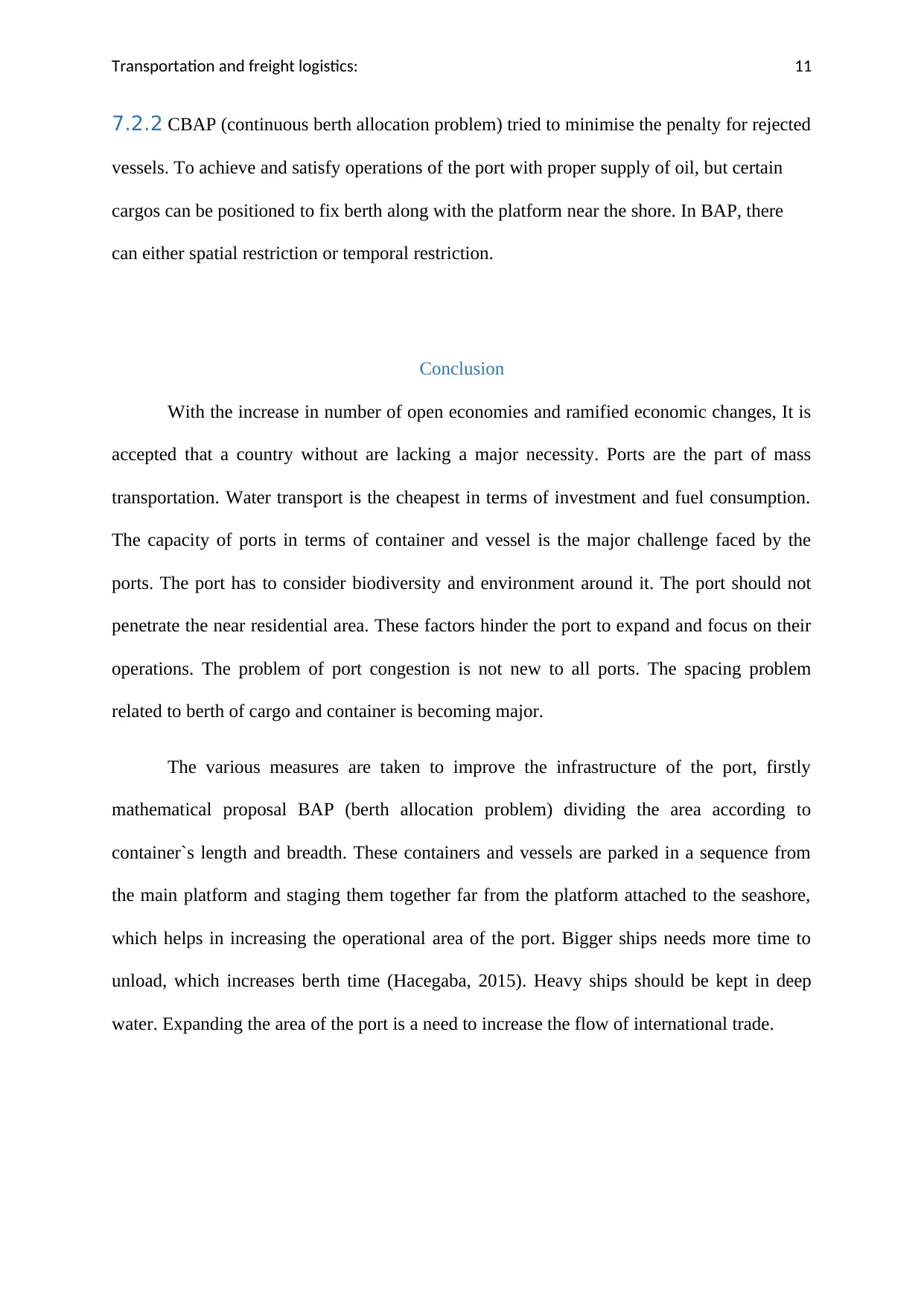
Transportation and freight logistics: 11
7.2.2 CBAP (continuous berth allocation problem) tried to minimise the penalty for rejected
vessels. To achieve and satisfy operations of the port with proper supply of oil, but certain
cargos can be positioned to fix berth along with the platform near the shore. In BAP, there
can either spatial restriction or temporal restriction.
Conclusion
With the increase in number of open economies and ramified economic changes, It is
accepted that a country without are lacking a major necessity. Ports are the part of mass
transportation. Water transport is the cheapest in terms of investment and fuel consumption.
The capacity of ports in terms of container and vessel is the major challenge faced by the
ports. The port has to consider biodiversity and environment around it. The port should not
penetrate the near residential area. These factors hinder the port to expand and focus on their
operations. The problem of port congestion is not new to all ports. The spacing problem
related to berth of cargo and container is becoming major.
The various measures are taken to improve the infrastructure of the port, firstly
mathematical proposal BAP (berth allocation problem) dividing the area according to
container`s length and breadth. These containers and vessels are parked in a sequence from
the main platform and staging them together far from the platform attached to the seashore,
which helps in increasing the operational area of the port. Bigger ships needs more time to
unload, which increases berth time (Hacegaba, 2015). Heavy ships should be kept in deep
water. Expanding the area of the port is a need to increase the flow of international trade.
7.2.2 CBAP (continuous berth allocation problem) tried to minimise the penalty for rejected
vessels. To achieve and satisfy operations of the port with proper supply of oil, but certain
cargos can be positioned to fix berth along with the platform near the shore. In BAP, there
can either spatial restriction or temporal restriction.
Conclusion
With the increase in number of open economies and ramified economic changes, It is
accepted that a country without are lacking a major necessity. Ports are the part of mass
transportation. Water transport is the cheapest in terms of investment and fuel consumption.
The capacity of ports in terms of container and vessel is the major challenge faced by the
ports. The port has to consider biodiversity and environment around it. The port should not
penetrate the near residential area. These factors hinder the port to expand and focus on their
operations. The problem of port congestion is not new to all ports. The spacing problem
related to berth of cargo and container is becoming major.
The various measures are taken to improve the infrastructure of the port, firstly
mathematical proposal BAP (berth allocation problem) dividing the area according to
container`s length and breadth. These containers and vessels are parked in a sequence from
the main platform and staging them together far from the platform attached to the seashore,
which helps in increasing the operational area of the port. Bigger ships needs more time to
unload, which increases berth time (Hacegaba, 2015). Heavy ships should be kept in deep
water. Expanding the area of the port is a need to increase the flow of international trade.
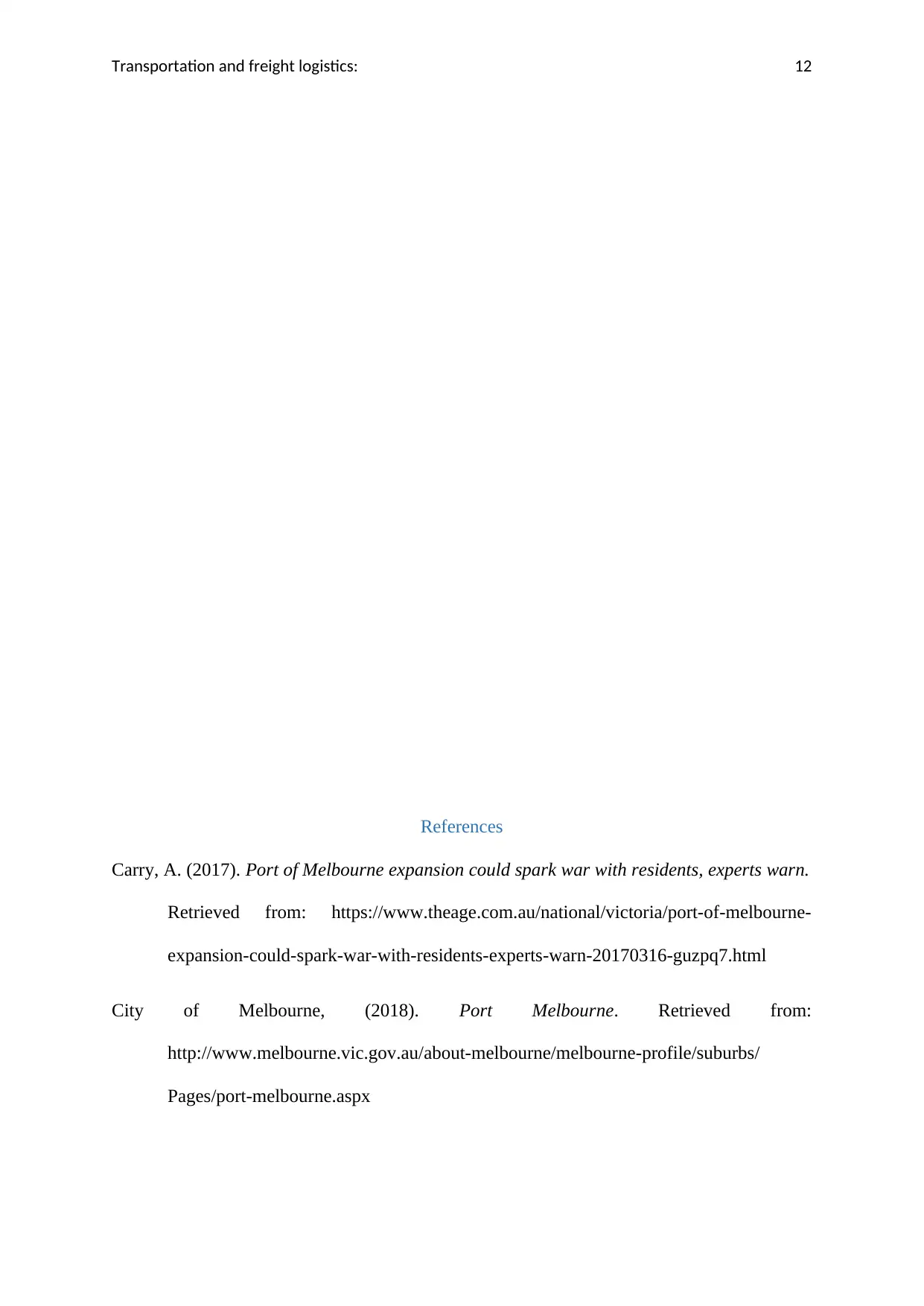
Transportation and freight logistics: 12
References
Carry, A. (2017). Port of Melbourne expansion could spark war with residents, experts warn.
Retrieved from: https://www.theage.com.au/national/victoria/port-of-melbourne-
expansion-could-spark-war-with-residents-experts-warn-20170316-guzpq7.html
City of Melbourne, (2018). Port Melbourne. Retrieved from:
http://www.melbourne.vic.gov.au/about-melbourne/melbourne-profile/suburbs/
Pages/port-melbourne.aspx
References
Carry, A. (2017). Port of Melbourne expansion could spark war with residents, experts warn.
Retrieved from: https://www.theage.com.au/national/victoria/port-of-melbourne-
expansion-could-spark-war-with-residents-experts-warn-20170316-guzpq7.html
City of Melbourne, (2018). Port Melbourne. Retrieved from:
http://www.melbourne.vic.gov.au/about-melbourne/melbourne-profile/suburbs/
Pages/port-melbourne.aspx
Paraphrase This Document
Need a fresh take? Get an instant paraphrase of this document with our AI Paraphraser

Transportation and freight logistics: 13
Elwany, M. H., Ali, I., & Abouelseoud, Y. (2013). A heuristics-based solution to the
continuous berth allocation and crane assignment problem. Alexandria Engineering
Journal, 52(4), 671-677.
Ganji, S. R. S., Babazadeh, A., & Arabshahi, N. (2010). Analysis of the continuous berth
allocation problem in container ports using a genetic algorithm. Journal of Marine
Science and Technology, 15(4), 408-416.
Hacegaba, N. (2015). Bold solutions: how seaports can conquer congestion. Retrieved from:
http://www.polb.com/civica/filebank/blobdload.asp?BlobID=12788
Insight, (2016). Five challenges en route to the Port of 2050. Retrieved from:
https://www.portofrotterdam.com/en/news-and-press-releases/five-challenges-en-
route-to-the-port-of-2050
MH&L, (2018). Technology and automation. Retreived from:
https://www.mhlnews.com/technology-automation/building-connected-smart-port-future
National Transport Commission, (2013). International ports and supply chain observations.
Retrieved from: https://www.ntc.gov.au/Media/Reports/(2D028DAB-04FE-4298-
93E4-F0EB4AE65523).pdf
Port technology, (2018). 5 Challenges for Ports in 2050. Retrieved from:
https://www.porttechnology.org/news/5_challenges_for_ports_in_2050
Portofmelbourne, (2018). Port operations. Retrieved from:
https://www.portofmelbourne.com/about-us/about-the-port/port-operations/
Portofrotterdam, (2018). Port of Rotterdam. Retrieved from:
https://www.portofrotterdam.com/en/port-authority/about-the-port-authority
Elwany, M. H., Ali, I., & Abouelseoud, Y. (2013). A heuristics-based solution to the
continuous berth allocation and crane assignment problem. Alexandria Engineering
Journal, 52(4), 671-677.
Ganji, S. R. S., Babazadeh, A., & Arabshahi, N. (2010). Analysis of the continuous berth
allocation problem in container ports using a genetic algorithm. Journal of Marine
Science and Technology, 15(4), 408-416.
Hacegaba, N. (2015). Bold solutions: how seaports can conquer congestion. Retrieved from:
http://www.polb.com/civica/filebank/blobdload.asp?BlobID=12788
Insight, (2016). Five challenges en route to the Port of 2050. Retrieved from:
https://www.portofrotterdam.com/en/news-and-press-releases/five-challenges-en-
route-to-the-port-of-2050
MH&L, (2018). Technology and automation. Retreived from:
https://www.mhlnews.com/technology-automation/building-connected-smart-port-future
National Transport Commission, (2013). International ports and supply chain observations.
Retrieved from: https://www.ntc.gov.au/Media/Reports/(2D028DAB-04FE-4298-
93E4-F0EB4AE65523).pdf
Port technology, (2018). 5 Challenges for Ports in 2050. Retrieved from:
https://www.porttechnology.org/news/5_challenges_for_ports_in_2050
Portofmelbourne, (2018). Port operations. Retrieved from:
https://www.portofmelbourne.com/about-us/about-the-port/port-operations/
Portofrotterdam, (2018). Port of Rotterdam. Retrieved from:
https://www.portofrotterdam.com/en/port-authority/about-the-port-authority

Transportation and freight logistics: 14
Portoftechnology, (2018). Port of technology. Retrieved from:
https://www.porttechnology.org/technical_papers/security_in_the_port_of_rotterdam
Rodrigue, J. P. & Notteboom, T. (2018). Port Terminals. Retrieved from:
https://transportgeography.org/?page_id=3235
Rotterdam, (2018). Rotterdam tourist information. Retrieved from:
https://en.rotterdam.info/locations/the-port/
Sexton, D. (2017). Challenge to accommodate larger ships at Melbourne. Retrieved from:
http://www.thedcn.com.au/challenge-to-accommodate-larger-ships-at-melbourne/
Wilmsmeier, G., Martinez-Zarzoso, I. (2010), Determinants of maritime transport costs: a
panel data analysis for Latin American trade, Transport Planning and Technology,
33(1).
Portoftechnology, (2018). Port of technology. Retrieved from:
https://www.porttechnology.org/technical_papers/security_in_the_port_of_rotterdam
Rodrigue, J. P. & Notteboom, T. (2018). Port Terminals. Retrieved from:
https://transportgeography.org/?page_id=3235
Rotterdam, (2018). Rotterdam tourist information. Retrieved from:
https://en.rotterdam.info/locations/the-port/
Sexton, D. (2017). Challenge to accommodate larger ships at Melbourne. Retrieved from:
http://www.thedcn.com.au/challenge-to-accommodate-larger-ships-at-melbourne/
Wilmsmeier, G., Martinez-Zarzoso, I. (2010), Determinants of maritime transport costs: a
panel data analysis for Latin American trade, Transport Planning and Technology,
33(1).
1 out of 15
Related Documents
Your All-in-One AI-Powered Toolkit for Academic Success.
+13062052269
info@desklib.com
Available 24*7 on WhatsApp / Email
![[object Object]](/_next/static/media/star-bottom.7253800d.svg)
Unlock your academic potential
© 2024 | Zucol Services PVT LTD | All rights reserved.




